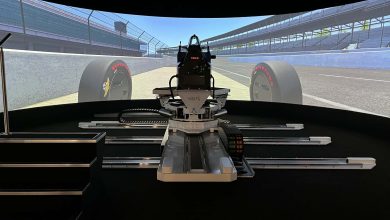Making New Tires for Old Cars Is Hard

You know you’re a real car nerd when you start paying attention to the tires on old cars. It drives me slightly mad to see something vintage on modern tires. It’s like an anachronistic detail in a period film that’s just prominent enough to suspend your disbelief. (The 1973 Porsche 911 in Tarantino’s Once Upon a Time In Hollywood, which is set in 1969 springs to mind). There are, thankfully, others who think like me, and in recent years, a budding classic car tire business has emerged.
And it’s not just for the looks. Since the beginning, cars have been designed to leverage the available tire technology. The tire is perhaps the most important part of a car. It’s the only part that touches the car, and it affects everything from efficiency to performance, and ride and handling. It’s also an integral part of a vehicle’s suspension system, and as such, it informs so many of the decisions that go into making the car. Today’s tires are designed to work with today’s cars, not yesterday’s. Maybe there’s a modern tire that fits an old car, but it’ll be far from optimized, possibly spoiling the ride and handling.
A handful of companies make new tires for old cars. Michelin offers a wide range, Vredestein has the long-running Sprint Classic, and UK specialist Blockley specializes in pre-War up through mid-century cars. Pirelli created its Collezione program in 2020, and it sells everything from the tiny tires of the classic Fiat 500, to a new high-performance offering for the Ferrari Enzo.
Pirelli’s new Ferrari Enzo tires.
The idea, according to Emanuelle Vanzetti, the engineer in charge of the Collezione program, is to make tires that are “100 percent respectful of the original look, but they’re also, as much as possible, respectful of the original handling and driving style.”
The Pirelli Collezione falls under the umbrella of the company’s motorsport department because, like racing tires, these tires are made in relatively small quantities, partially by hand. They’re made in the same factories, too, in Turkey and Brazil.
For Vanzetti, there’s a very tricky balance to strike because you need to make tires that look and feel right on an older car, often creating a tire that’s objectively not as good as it could be.
“It’s quite different when you judge a tire from its properties itself and from how it behaves on the car,” he says. “If we look at the tire’s characteristics alone on a [test] rig, these tires may not perform so well, and that’s the reason why the product evolved so much in the last decades, and cars evolved along tires. So, it would be both inefficient to fit these vintage tires on modern cars, but also fitting modern tires on vintage cars could easily spoil the driving feeling.”
In some ways, this runs counter to what Pirelli does at large. Its primary goal is to make ever-better tires that evolve along with today’s cars, and on a smaller scale, the motorsport department shares similar goals. It’s trying to make stuff that’s faster and more durable—or at the very least, meets the requirements of a racing series. But with new tires for old cars, you give up on outright performance potential for something that better suits the design of the original car.


In the Collezione, Pirelli uses iconic names and tread patterns from the past, and while these new tires are based on these classics, they are not simply reproductions. Vanzetti says the team starts with original drawings and information from Pirelli’s extensive archives—they have access to specs dating back to the 1930s—plus period magazine road tests, to try and get a sense of the original design brief, but the original molds are long since gone. They tend to rust and wear away with age, so even if they were still around, they wouldn’t be terribly useful for making new tires.
Then there’s the actual rubber. “There has been a continuous evolution in which kind of materials we can and cannot use,” Vanzetti says. “It would be impossible to reproduce 100 percent. Even if we knew how to do it would be impossible to reproduce the original materials, because the environmental and safety regulations have evolved.”
Modern compounds can also bring huge increases in performance too, and while these tires are meant to compliment older cars, there’s no reason not to boost capability too. Tire technology has made huge strides over the years, especially in wet-weather performance. Ultimately, it’s a safety thing.

Maserati Biturbo with new Pirelli tires
There is some level of guesswork too because it’s impossible to know exactly how a car felt in its day. Vanzetti told a story about working with Maserati on creating a new version of the Cinturato P7 for the Biturbo of the 1980s. One of the original development drivers on the car still worked for Maserati, and helped Pirelli develop the new tire shortly before his retirement. But that sort of first-hand knowledge, especially on cars fifty years or older, is rare.
In addition to the aforementioned collaborations with Maserati and Ferrari, Pirelli has also worked with Lamborghini on tires for the LM002, and Porsche, for a variety of models, plus others. In fact, Porsche gave a new version of the iconic Cinturato CN36 an official approval before the Collezione was even started. Some automakers request specific tires from Pirelli, Maserati for example, and Vanzetti even says they’ll do extremely limited runs or one-offs for museum pieces. But the tire maker itself also looks at popular sizes for classic cars and what else is on the market.


Ideally, the Pirelli team will do real-world testing with the actual car, and if they’re working with an automaker, they’ll get info on the car’s weight distribution, and all the details on the suspension setup. But sometimes, they have to do all that work themselves.
What’s funny is that Vanzetti says developing tires for newer cars like the Enzo can be more of a challenge than classics. Owners aren’t likely to thrash cars from the 1950s or 1960s on track, but stuff from the 1980s and up? Different story. And in the case of a car like the Enzo, it’s still an extremely fast car, and one capable of putting a lot of energy into its tires.
It’s only a small part of Pirelli’s business, but it’s something the company clearly finds important. These tires are expensive and labor-intensive, but they go on some of the most special cars in the world. And if you own something so rarefied, don’t you want the right rubber?
Read the full article here








